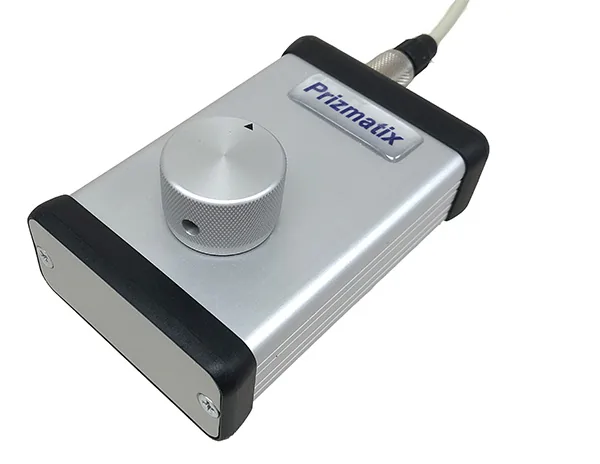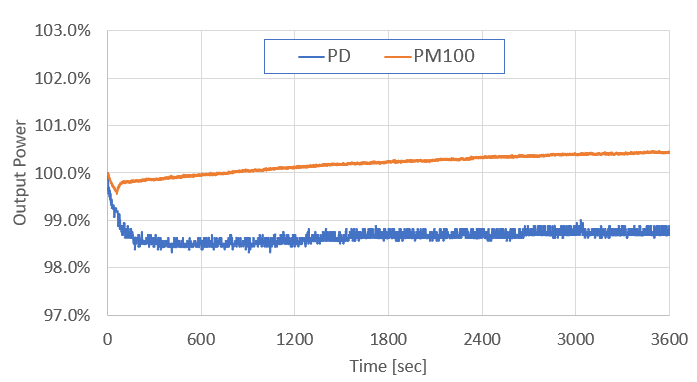Prizmatix UHP-F-LED series of Ultra High Power LED light-guide coupled light sources was designed especially for microscopy and OEM illumination applications in life science instrumentation, machine vision, confocal microscopy and many others.
The UHP-F-LED housing is self-contained liquid lightguide LED source including all necessary driver electronics and thermal management, no special controller box is required to operate the module if used at maximum power.
The device features opto-isolated TTL and Analog input for convenient control of fast pulsing (strobe applications) and output power. The device has I2C input for easy power control (12 Bit DAC) from microcontroller.
![]() UHP-F-LED
UHP-F-LED
 YouTube video: Unboxing Prizmatix UHP-F-LED.
YouTube video: Unboxing Prizmatix UHP-F-LED.
Key Features:
- Ultra High Power LED
- Shielded LED head with high current driver, low RFI/EMI
- Optically isolated TTL input for external triggering or strobe operation
- Optically isolated Analog input (0-5V) for LED power control by an external device like D/A
- Computer control via USB from Windows / Mac / RaspberryPI.
- API and code examples available for LabVIEW, LabWindows/CVI, C++, Python, and others.
- Stable precisely adjustable power.
- Long life.
- Low optical noise (Optional).
- Simple integration for OEM.
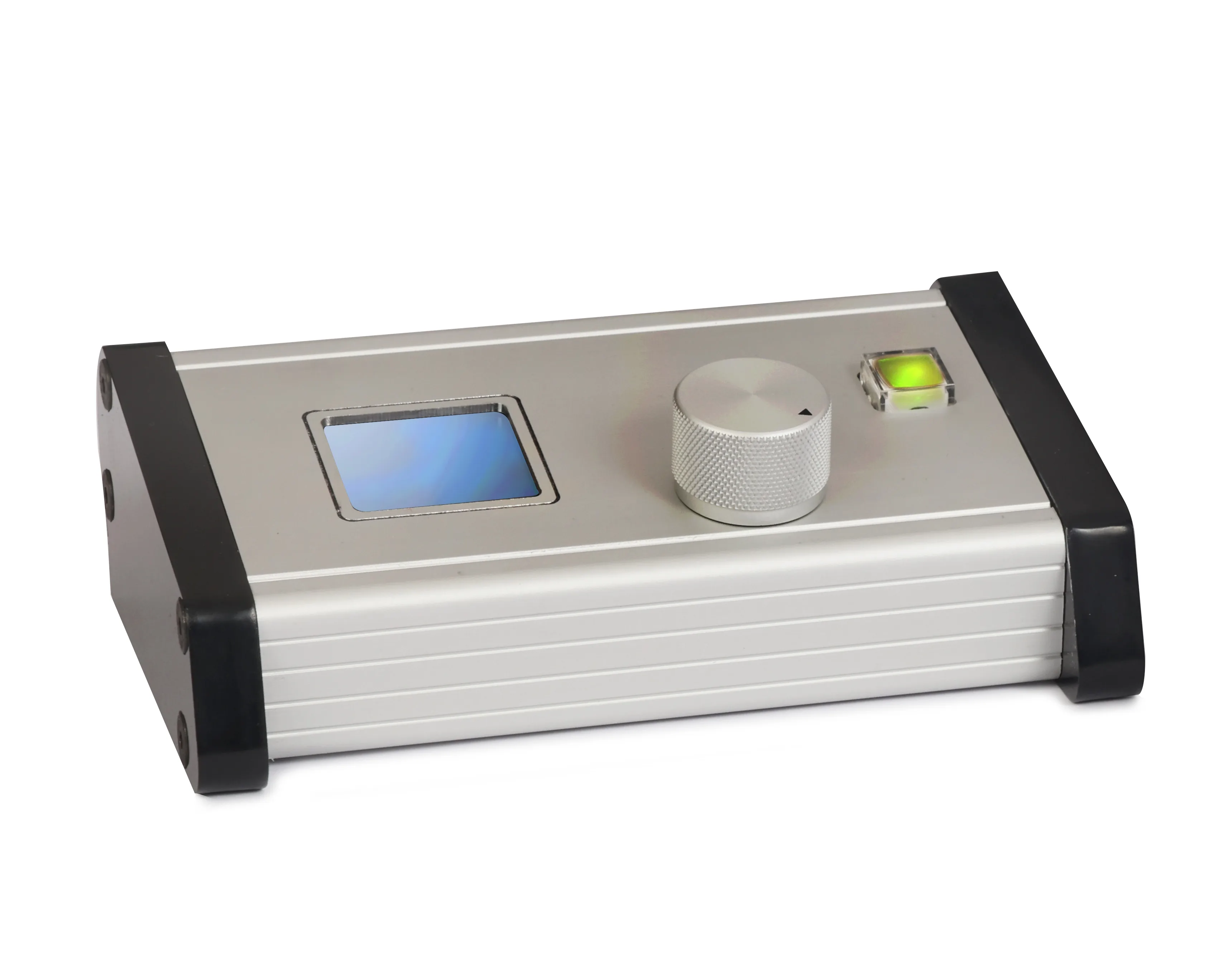
|
Some Research Papers with Reference to Prizmatix UHP-F-LEDs
|
Applications:
- Routine microscopy and cell culture microscopy
- Bio-instrumentation
- Curing of UV adhesives
- Machine vision
- Lightguide Coupled LED Illuminator for Bio Incubator
The CTRL-F and UHP-F-USB can be connected in chain so user can operate the LED manaully and from computer without a need to disconnect and reconnect cables (see Configuration F below).
If UHP-F-LED need to operate in Pulsed mode the Fuction Generator can be used with any of describer power control options, so the intensity of the pulses can be controller through CTRL-F or UHP-F-USB or eben by Analog input. (as example see Configuration G below).
|
Configuration A: |
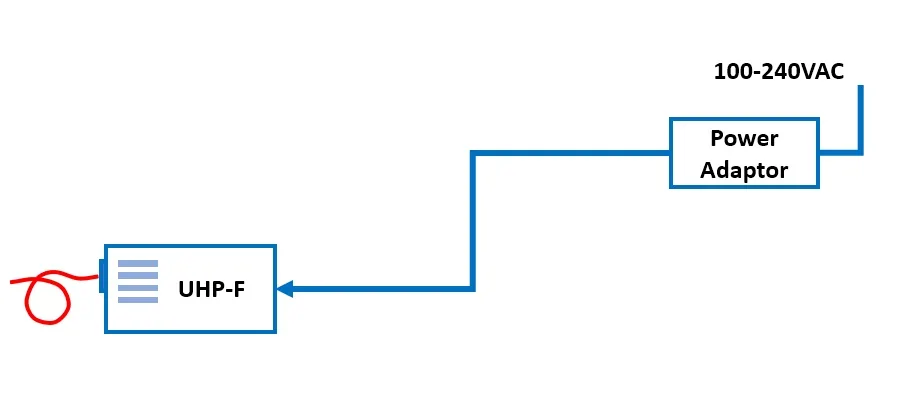
|
|
Configuration B: |
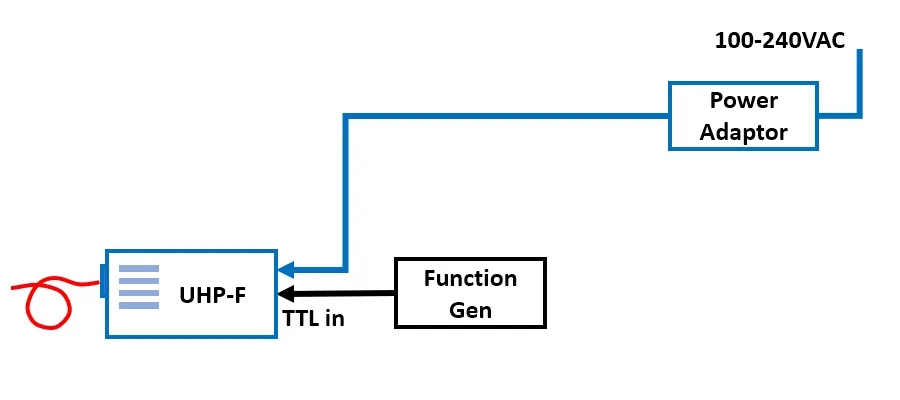
|
|
Configuration C: |
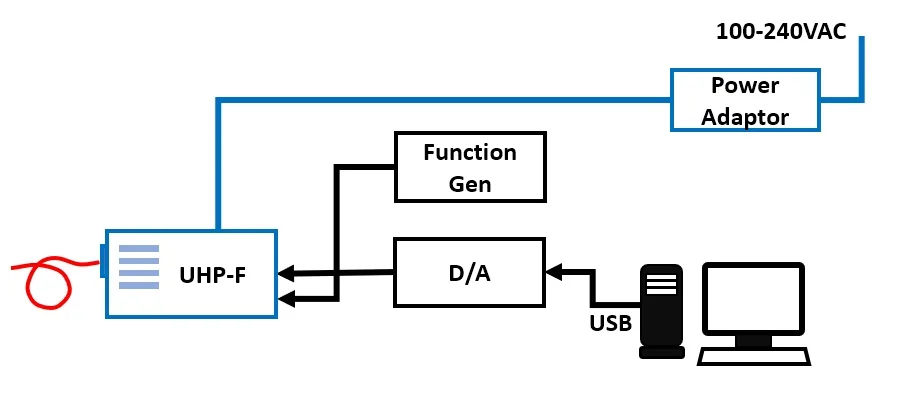
|
|
Configuration D: |
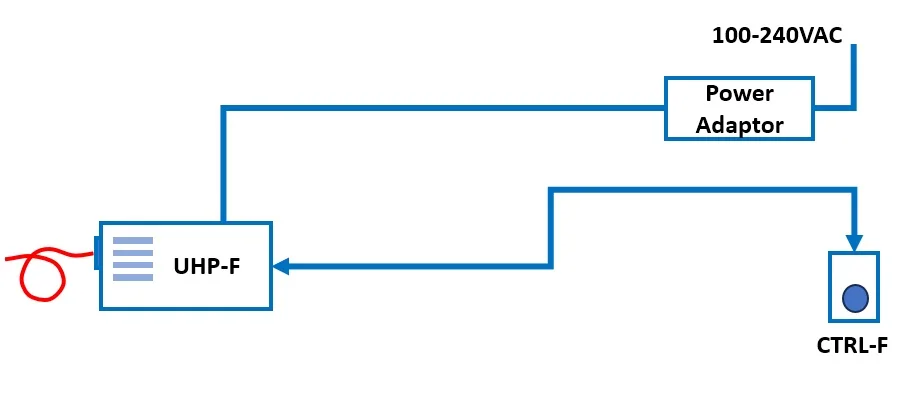
|
|
Configuration E: |
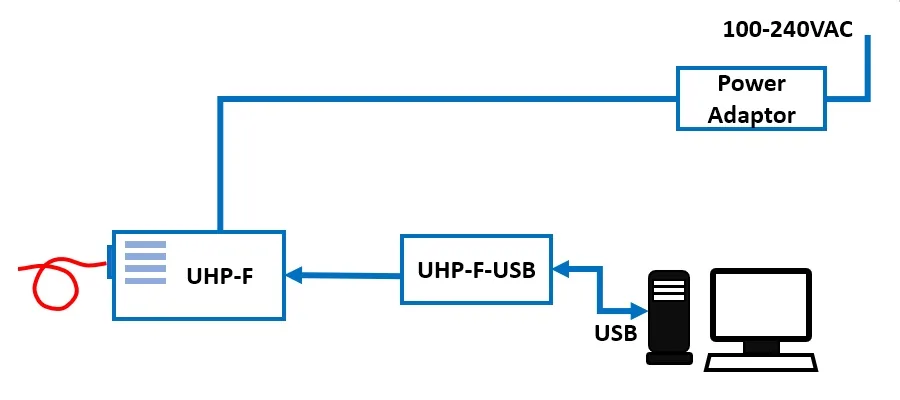
|
|
Configuration F: |
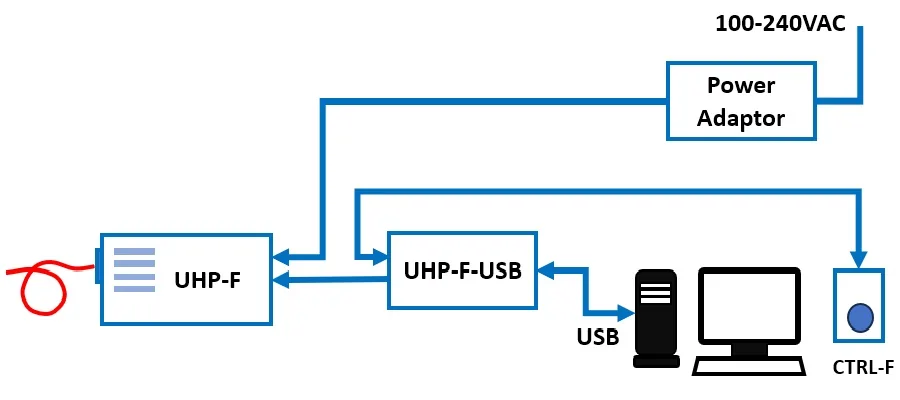
|
|
Configuration G: |
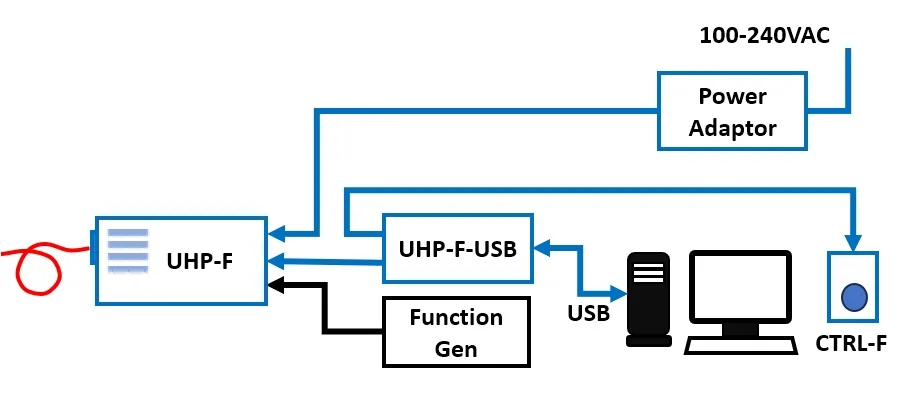
|
Electrical Specifications:
| Digital modulation (TTL Input) | Hz | DC-30000 |
| Analog modulation (Analog Input) | Hz | DC-100 |
| Analog power control | % | 0-100 |
| ON/OFF | Power switch or by TTL signal | |
| Supply voltage | V | 12 |
| Power adaptor input | 85-264 VAC, 47-63Hz, 1.5A |
General Specifications:
| Operation temperature range | 0C | 10-35 |
| Storage temperature range | 0C | -10-55 |
| Operative relative humidity (Non condensing) | % | <90 |
| Dimensions | See drawing below | |
| Head weight | g | 750 |
| Power adaptor dimensions (L x W x H) |
mm | 167 x 67 x 35 |
| Power adaptor weight | g | 590 |
| Power adaptor safety |
Mechanical Drawings
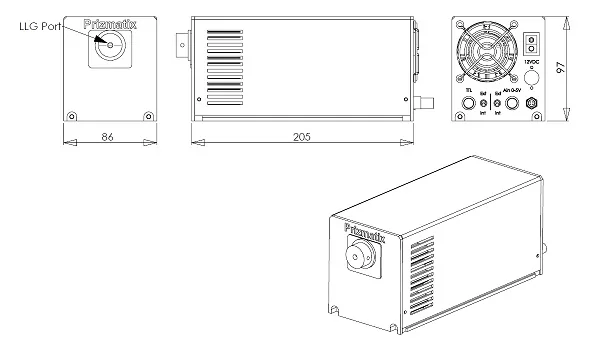
Remarks:
- LLG Port is designed for Prizmatix standard light-guides.
- For more information see Ordering Information below and Prizmatix Liquid light-guide.
- LLG port and mounting options may vary according to customer's specifications.
- Specifications subject to changes without notice.
UHP-F-LED Frequently Asked Questions (FAQs)
- Q: What are the advantages of a Liquid Light Guide (LLG) compared to a Fiber Optic Bundle (FOB)?
- A: Liquid Light Guides offer three primary advantages over traditional Fiber Optic Bundles: superior light transmission, more uniform illumination, and greater durability.
1.Higher Transmission Efficiency (No Fill-Factor Loss)
A Fiber Optic Bundle is an assembly of numerous discrete optical fibers. Due to the circular cross-section of these fibers, their packing within the bundle ferrule creates unavoidable interstitial voids. The ratio of the active fiber core area to the total bundle core area is known as the "fill-factor." For a typical randomized bundle, the fill-factor is approximately 68%, meaning that 32% of the input facet area is non-transmissive, resulting in a significant and immediate loss of input power. A Liquid Light Guide, in contrast, has a continuous liquid core that uses the entire guide diameter for light transmission, resulting in significantly higher efficiency.2.Superior Light Homogeneity (Uniformity)
Fiber Optic Bundles attempt to create uniform light output by randomizing the arrangement of the individual fibers from the proximal to the distal end. However, this process is never perfect and worsens over time as fibers break, leading to inconsistent illumination. A Liquid Light Guide achieves superior homogenization intrinsically. Light propagates through the liquid medium via a vast number of transmission modes. This high degree of modal dispersion acts as a natural and highly effective mixing mechanism, producing an exceptionally homogeneous output profile at the distal end.3.Enhanced Durability and Reliability
The multi-fiber construction of an FOB is its primary failure point. The randomization process itself introduces structural disorder, creating unequal mechanical stress during bending or vibration. This stress, along with other failure mechanisms, leads to fiber breakage over time. This degradation is visually apparent as "dead pixels"—dark, non-transmissive spots—that irreversibly diminish the bundle's performance.
Liquid Light Guides contain no fragile fibers. Their robust, one-piece construction makes them immune to this type of failure, ensuring consistent, reliable performance.
Ordering Information
| Item Description | P/N |
|---|---|
|
Ultra-High Power LED for 3mm light-guide (LLG-3) for microscopy and various illumination applications. Please specify wavelength or Compatible only with Prizmatix LLG-3 (not included), see below. |
UHP-F-3-WL (WL - See the full list of the available wavelengths in the table above) |
|
Ultra-High Power LED for 5mm light-guide (LLG-5) for microscopy and various illumination applications. Please specify wavelength or Compatible only with Prizmatix LLG-5 (not included), see below. |
UHP-F-5-WL (WL - See the full list of the available wavelengths in the table above) |
|
Prizmatix Light-guide. Core diameter 3mm. |
LLG-3 |
|
Prizmatix Light-guide. Core diameter 5mm. |
LLG-5 |
|
Optional wired remote-control unit for manual control of the UHP-F illuminator. |
CTRL-F |
|
Optional wired remote-control unit for precise manual control of the UHP-X illuminator. This wired remote lets you adjust power from 0%-100% or with discrete DAC levels (0-4095). A convenient On/Off button allows you to toggle the light without losing your current power settings. A connecting cable is included. Cable is included. |
UHP-F-Console |
|
USB to UHP-F interface box. |
UHP-F-USB |
|
RS232 interface box. |
UHP-F-RS232 |
|
Collimator for 3mm core liquid light-guide (LLG-3). 1 inch output. No XY adjustment. |
LLG3-CM1 |
|
Collimator for 5mm core liquid light-guide (LLG-5). 1 inch output. No XY adjustment. |
LLG5-CM1 |
|
Collimator with XYZ adjustment for LLG-3 light-guide. |
LLG3-CXYZ-Type (Type = N / O / Z / L) |
|
Collimator with XYZ adjustment for LLG-5 light-guide. |
LLG5-CXYZ-Type (Type = N / O / Z / L) |


